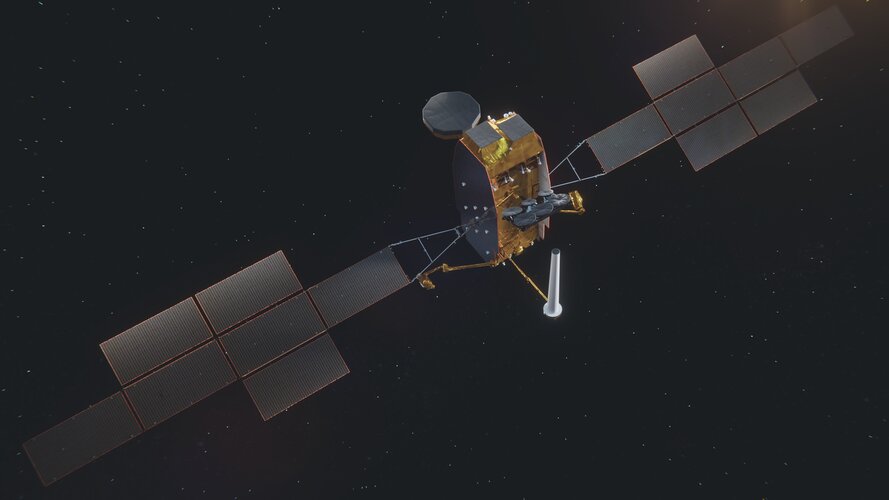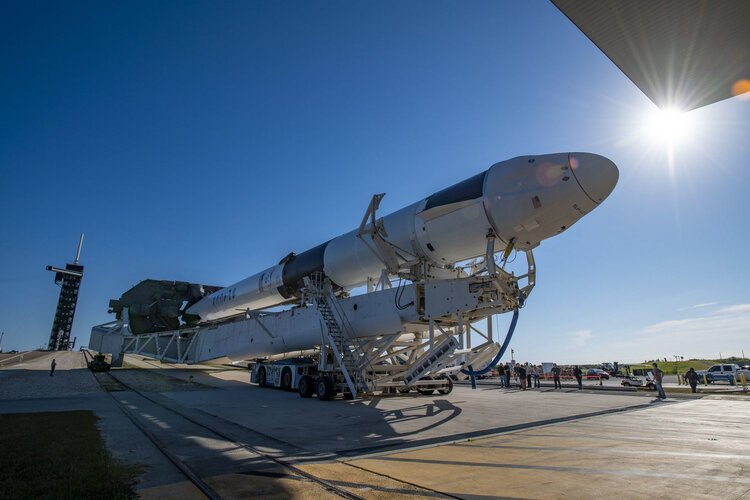
Copernical Team
Monday, 20 December 2021 07:57
Japanese space tourists safely return to Earth

Published in
News
Tagged under
Monday, 20 December 2021 10:30
Secure Spanish satellites start construction

Two telecommunications satellites that can be reprogrammed while in space to respond to changing demands on Earth have passed their critical design reviews.
Published in
News
Tagged under
Monday, 20 December 2021 08:42
Dragon delivery – European science destined for space

The next SpaceX resupply vehicle is packed with European science, ready for delivery to the International Space Station just in time for Christmas.
Published in
News
Tagged under
Monday, 20 December 2021 05:16
Japanese space tourists return to Earth after 12 days on ISS
Almaty, Kazakhstan (AFP) Dec 20, 2021
 A Japanese billionaire returned to Earth Monday, after 12 days spent on the International Space Station where he made videos about performing mundane tasks in space including brushing teeth and going to the bathroom.
Online fashion tycoon Yusaku Maezawa and his assistant Yozo Hirano parachuted onto Kazakhstan's steppe at around the expected landing time of 0313 GMT Monday, along with Russia
A Japanese billionaire returned to Earth Monday, after 12 days spent on the International Space Station where he made videos about performing mundane tasks in space including brushing teeth and going to the bathroom.
Online fashion tycoon Yusaku Maezawa and his assistant Yozo Hirano parachuted onto Kazakhstan's steppe at around the expected landing time of 0313 GMT Monday, along with Russia
 A Japanese billionaire returned to Earth Monday, after 12 days spent on the International Space Station where he made videos about performing mundane tasks in space including brushing teeth and going to the bathroom.
Online fashion tycoon Yusaku Maezawa and his assistant Yozo Hirano parachuted onto Kazakhstan's steppe at around the expected landing time of 0313 GMT Monday, along with Russia
A Japanese billionaire returned to Earth Monday, after 12 days spent on the International Space Station where he made videos about performing mundane tasks in space including brushing teeth and going to the bathroom.
Online fashion tycoon Yusaku Maezawa and his assistant Yozo Hirano parachuted onto Kazakhstan's steppe at around the expected landing time of 0313 GMT Monday, along with Russia
Published in
News
Tagged under
Sunday, 19 December 2021 16:00
NASA craft 'touches' sun for 1st time, dives into atmosphere

Published in
News
Tagged under
Sunday, 19 December 2021 09:00
'Alarm bells' as UN validates record Arctic temperature
Geneva (AFP) Dec 14, 2021
 The UN on Tuesday officially recognised the 38 degrees Celsius measured in Siberia last year as a new record high for the Arctic, sounding "alarm bells" over climate change.
The sweltering heat - equivalent to 100.4 degrees Fahrenheit - was seen on June 20, 2020 in the Russian town of Verkhoyansk, marking the highest temperature ever recorded above the Arctic Circle, the World Meteorologic
The UN on Tuesday officially recognised the 38 degrees Celsius measured in Siberia last year as a new record high for the Arctic, sounding "alarm bells" over climate change.
The sweltering heat - equivalent to 100.4 degrees Fahrenheit - was seen on June 20, 2020 in the Russian town of Verkhoyansk, marking the highest temperature ever recorded above the Arctic Circle, the World Meteorologic
 The UN on Tuesday officially recognised the 38 degrees Celsius measured in Siberia last year as a new record high for the Arctic, sounding "alarm bells" over climate change.
The sweltering heat - equivalent to 100.4 degrees Fahrenheit - was seen on June 20, 2020 in the Russian town of Verkhoyansk, marking the highest temperature ever recorded above the Arctic Circle, the World Meteorologic
The UN on Tuesday officially recognised the 38 degrees Celsius measured in Siberia last year as a new record high for the Arctic, sounding "alarm bells" over climate change.
The sweltering heat - equivalent to 100.4 degrees Fahrenheit - was seen on June 20, 2020 in the Russian town of Verkhoyansk, marking the highest temperature ever recorded above the Arctic Circle, the World Meteorologic
Published in
News
Tagged under
Sunday, 19 December 2021 09:00
New copper surface eliminates bacteria in just two minutes
Melbourne, Australia (SPX) Dec 15, 2021
 A new copper surface that kills bacteria more than 100 times faster and more effectively than standard copper could help combat the growing threat of antibiotic-resistant superbugs.
The new copper product is the result of a collaborative research project with RMIT University and Australia's national science agency, CSIRO, with findings just published in Biomaterials.
Copper has long
A new copper surface that kills bacteria more than 100 times faster and more effectively than standard copper could help combat the growing threat of antibiotic-resistant superbugs.
The new copper product is the result of a collaborative research project with RMIT University and Australia's national science agency, CSIRO, with findings just published in Biomaterials.
Copper has long
 A new copper surface that kills bacteria more than 100 times faster and more effectively than standard copper could help combat the growing threat of antibiotic-resistant superbugs.
The new copper product is the result of a collaborative research project with RMIT University and Australia's national science agency, CSIRO, with findings just published in Biomaterials.
Copper has long
A new copper surface that kills bacteria more than 100 times faster and more effectively than standard copper could help combat the growing threat of antibiotic-resistant superbugs.
The new copper product is the result of a collaborative research project with RMIT University and Australia's national science agency, CSIRO, with findings just published in Biomaterials.
Copper has long
Published in
News
Tagged under
Sunday, 19 December 2021 09:00
New research explains Earth's peculiar chemical composition
Tokyo, Japan (SPX) Dec 15, 2021
 Earth's surface environment hosts large reservoirs of hydrogen (H, mainly in the form of water, H2O), nitrogen (in atmospheric N2) and carbon (mainly in carbonate rocks). H, N and C are sometimes called "volatile" elements, or simply "volatiles," by geoscientists because many of the simple compounds they form are gases at standard temperature and pressure. However, the distribution of these vola
Earth's surface environment hosts large reservoirs of hydrogen (H, mainly in the form of water, H2O), nitrogen (in atmospheric N2) and carbon (mainly in carbonate rocks). H, N and C are sometimes called "volatile" elements, or simply "volatiles," by geoscientists because many of the simple compounds they form are gases at standard temperature and pressure. However, the distribution of these vola
 Earth's surface environment hosts large reservoirs of hydrogen (H, mainly in the form of water, H2O), nitrogen (in atmospheric N2) and carbon (mainly in carbonate rocks). H, N and C are sometimes called "volatile" elements, or simply "volatiles," by geoscientists because many of the simple compounds they form are gases at standard temperature and pressure. However, the distribution of these vola
Earth's surface environment hosts large reservoirs of hydrogen (H, mainly in the form of water, H2O), nitrogen (in atmospheric N2) and carbon (mainly in carbonate rocks). H, N and C are sometimes called "volatile" elements, or simply "volatiles," by geoscientists because many of the simple compounds they form are gases at standard temperature and pressure. However, the distribution of these vola
Published in
News
Tagged under
Sunday, 19 December 2021 09:00
NOAA's Arctic report card finds 'alarming' trend in climate crisis
Washington DC (UPI) Dec 14, 2021
 The National Oceanic and Atmospheric Administration's 2021 Arctic report card shows a region transformed by human-caused climate change, a thawing of a once reliably frozen region.
"The Arctic Report Card continues to show how the impacts of human-caused climate change are propelling the Arctic region into a dramatically different state than it was in just a few decades ago," said NOAA
The National Oceanic and Atmospheric Administration's 2021 Arctic report card shows a region transformed by human-caused climate change, a thawing of a once reliably frozen region.
"The Arctic Report Card continues to show how the impacts of human-caused climate change are propelling the Arctic region into a dramatically different state than it was in just a few decades ago," said NOAA
 The National Oceanic and Atmospheric Administration's 2021 Arctic report card shows a region transformed by human-caused climate change, a thawing of a once reliably frozen region.
"The Arctic Report Card continues to show how the impacts of human-caused climate change are propelling the Arctic region into a dramatically different state than it was in just a few decades ago," said NOAA
The National Oceanic and Atmospheric Administration's 2021 Arctic report card shows a region transformed by human-caused climate change, a thawing of a once reliably frozen region.
"The Arctic Report Card continues to show how the impacts of human-caused climate change are propelling the Arctic region into a dramatically different state than it was in just a few decades ago," said NOAA
Published in
News
Tagged under
Sunday, 19 December 2021 09:00
Space-bound research a step toward feeding Earth's people
Clemson SC (SPX) Dec 15, 2021
 Clemson researcher Chris Saski admits sending the University's iconic Tiger Paw to space aboard a SpaceX Dragon spacecraft is, quite literally, "an out-of-this-world experience."
But it's the potential for the experiments in the flight hardware to which the Paw is attached that truly excites him.
Saski's cotton regeneration research, adorned with Clemson stickers, intends to take off
Clemson researcher Chris Saski admits sending the University's iconic Tiger Paw to space aboard a SpaceX Dragon spacecraft is, quite literally, "an out-of-this-world experience."
But it's the potential for the experiments in the flight hardware to which the Paw is attached that truly excites him.
Saski's cotton regeneration research, adorned with Clemson stickers, intends to take off
 Clemson researcher Chris Saski admits sending the University's iconic Tiger Paw to space aboard a SpaceX Dragon spacecraft is, quite literally, "an out-of-this-world experience."
But it's the potential for the experiments in the flight hardware to which the Paw is attached that truly excites him.
Saski's cotton regeneration research, adorned with Clemson stickers, intends to take off
Clemson researcher Chris Saski admits sending the University's iconic Tiger Paw to space aboard a SpaceX Dragon spacecraft is, quite literally, "an out-of-this-world experience."
But it's the potential for the experiments in the flight hardware to which the Paw is attached that truly excites him.
Saski's cotton regeneration research, adorned with Clemson stickers, intends to take off
Published in
News
Tagged under
